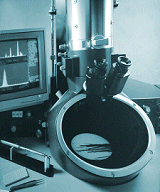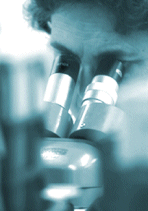|
Transmission Electron Microscopy (TEM)

TEM is the best analytical tool for the analysis of asbestos in air, water, dust, soil and special case building materials. By using electrons as a light source, TEM is capable of viewing very small fibers with incredible clarity The TEM can visualize the hollow tube inside an individual fiber of chrysotile asbestos and with EDXA detect the elements in that fiber!
"TEM is technical superior to PCM because it is capable of measuring all asbestos fibers including those thin fibers not measured by PCM." (EPA Federal Register 59 FR 5236-5260, 1994)
Phase Contrast Microscopy (PCM)
PCM is a light microscopy method for detection and quantification of fibers in air samples. The limit of detection of this method is approximately 5.0 microns in length and 0.25 microns in width. Fibers smaller than this are missed by this analysis. PCM cannot even differentiate asbestos fibers from non-asbestos fibers.
"EPA strongly recommends that abatement site air clearance samples collected from public and commercial buildings be analyzed by TEM at NVLAP accredited Laboratories. TEM is the more stringent analytical tool to be used for analysis of airborne asbestos during abatement site air clearance." (EPA Federal Register 59 FR 5236-5260, 1994)

Polarized Light Microscopy (PLM)
PLM is a light microscopy method that utilizes the mineral characteristics of the different types of asbestos fibers to identify and quantify the percentage in bulk materials. This method is EPA approved for most bulk materials but not recommended for certain EPA special case building materials. See our technical section on special case building materials.
Scanning Electron Microscopy (SEM)
SEM using an electron light source to view the surface structure of materials. In addition, an associated EDXA system can detect elemental composition of the surface being viewed. This type of instrumentation is invaluable in materials characterization of materials, metallurgical sciences and failure analysis.
|
